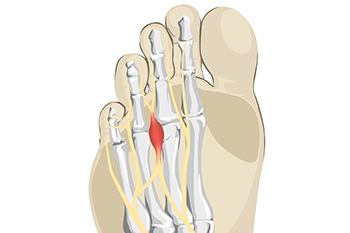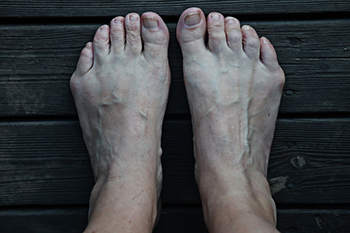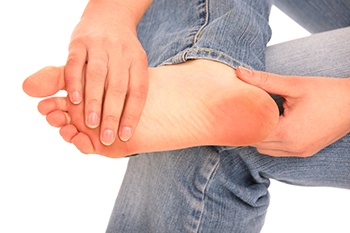Dallas Metro / North Texas
(214) 710-1028
November 2022
High Heels and Morton’s Neuroma

Morton’s neuroma is a foot condition that can develop in women who frequently wear high heels. This condition can result from having inadequate room for the toes to move freely in and can cause the nerve between the third and fourth toes to become compressed. Irritation and inflammation may accompany this, which can cause severe pain and discomfort. Patients who have Morton’s neuroma often say the sensation they feel is similar to having a pebble or marble in the shoe, in addition to numbness and tingling. Mild relief may also be found when soft insoles are worn, the feet are elevated, and shoes that are worn have a wide toe area. Existing medical conditions may contribute to Morton’s neuroma. These can include flat feet, bunions, and hammertoes. If you feel you may have this foot condition, it is advised that you speak to a podiatrist who can properly treat this ailment.
Morton’s neuroma is a very uncomfortable condition to live with. If you think you have Morton’s neuroma, contact Kellvan Cheng, DPM of Elite Foot & Ankle. Our doctor will attend to all of your foot care needs and answer any of your related questions.
Morton’s Neuroma
Morton's neuroma is a painful foot condition that commonly affects the areas between the second and third or third and fourth toe, although other areas of the foot are also susceptible. Morton’s neuroma is caused by an inflamed nerve in the foot that is being squeezed and aggravated by surrounding bones.
What Increases the Chances of Having Morton’s Neuroma?
- Ill-fitting high heels or shoes that add pressure to the toe or foot
- Jogging, running or any sport that involves constant impact to the foot
- Flat feet, bunions, and any other foot deformities
Morton’s neuroma is a very treatable condition. Orthotics and shoe inserts can often be used to alleviate the pain on the forefront of the feet. In more severe cases, corticosteroids can also be prescribed. In order to figure out the best treatment for your neuroma, it’s recommended to seek the care of a podiatrist who can diagnose your condition and provide different treatment options.
If you have any questions, please feel free to contact our office located in Carrollton, TX . We offer the newest diagnostic and treatment technologies for all your foot care needs.
What Is a Bunionette?

A bunionette, or tailor’s bunion, is a bony growth on the pinky toe classified as a deformity. It is the pinky counterpart of the more c,ommon bunion that forms on the big toe joint. When a bunionette and a bunion occur together, it is referred to as having a splayfoot. These growths are thought to develop from wearing narrow, tight shoes. However, some people may be genetically predisposed to bunions, due to an abnormality or enlargement of the toe ligament. Bunionettes can be visible to the eyes, swollen, and tender when palpated. If pain from a bunionette is not relieved with conservative treatments like wearing wider shoes or using orthotics, surgery may be necessary. If you have bunion problems and are experiencing discomfort, contact a podiatrist who can suggest the proper course of action for you.
If you are suffering from bunions, contact Kellvan Cheng, DPM of Elite Foot & Ankle. Our doctor can provide the care you need to keep you pain-free and on your feet.
What Is a Bunion?
A bunion is formed of swollen tissue or an enlargement of boney growth, usually located at the base joint of the toe that connects to the foot. The swelling occurs due to the bones in the big toe shifting inward, which impacts the other toes of the foot. This causes the area around the base of the big toe to become inflamed and painful.
Why Do Bunions Form?
Genetics – Susceptibility to bunions are often hereditary
Stress on the feet – Poorly fitted and uncomfortable footwear that places stress on feet, such as heels, can worsen existing bunions
How Are Bunions Diagnosed?
Doctors often perform two tests – blood tests and x-rays – when trying to diagnose bunions, especially in the early stages of development. Blood tests help determine if the foot pain is being caused by something else, such as arthritis, while x-rays provide a clear picture of your bone structure to your doctor.
How Are Bunions Treated?
- Refrain from wearing heels or similar shoes that cause discomfort
- Select wider shoes that can provide more comfort and reduce pain
- Anti-inflammatory and pain management drugs
- Orthotics or foot inserts
- Surgery
If you have any questions, please feel free to contact our office located in Carrollton, TX . We offer the newest diagnostic and treatment technologies for all your foot care needs.
Foot Conditions May Lead to Foot Pain

Many people experience foot pain in their lifetime, and it can occur for various reasons. Sudden pain can indicate a foot fracture has happened, and prompt medical attention is often sought. Conversely, foot pain may develop slowly, and can be in the form of aches, tenderness, or the feet may be itchy. Research has shown the feet are often affected in patients who have rheumatoid arthritis, which can cause the feet to have a limited range of motion. Gout is another condition that often begins with intense foot pain as a result of crystals that form in the joints of the big toe. Patients who do not have an arch are known to have flat feet, and this may possibly cause foot and ankle pain. If you have foot pain for any reason, it is strongly suggested that you are under the care of a podiatrist who can diagnose and treat any foot condition.
Foot Pain
Foot pain can be extremely painful and debilitating. If you have a foot pain, consult with Kellvan Cheng, DPM from Elite Foot & Ankle. Our doctor will assess your condition and provide you with quality foot and ankle treatment.
Causes
Foot pain is a very broad condition that could be caused by one or more ailments. The most common include:
- Bunions
- Hammertoes
- Plantar Fasciitis
- Bone Spurs
- Corns
- Tarsal Tunnel Syndrome
- Ingrown Toenails
- Arthritis (such as Gout, Rheumatoid, and Osteoarthritis)
- Flat Feet
- Injury (from stress fractures, broken toe, foot, ankle, Achilles tendon ruptures, and sprains)
- And more
Diagnosis
To figure out the cause of foot pain, podiatrists utilize several different methods. This can range from simple visual inspections and sensation tests to X-rays and MRI scans. Prior medical history, family medical history, and any recent physical traumatic events will all be taken into consideration for a proper diagnosis.
Treatment
Treatment depends upon the cause of the foot pain. Whether it is resting, staying off the foot, or having surgery; podiatrists have a number of treatment options available for foot pain.
If you have any questions, please feel free to contact our office located in Carrollton, TX . We offer the newest diagnostic and treatment technologies for all your foot care needs.
Recovering From Cuboid Syndrome

Cuboid syndrome is a condition of the foot that involves the cuboid bone. This bone is located on the outside of the foot and has a slightly cubical shape. If this bone moves out of alignment with the heel bone, this condition may develop. When determining how long it will take to recover from cuboid syndrome, it is important to consider several different relevant factors. Specifically, one’s recovery time from cuboid syndrome can depend on the duration of time in which the condition was present before treatment commenced. Additionally, recovery from cuboid syndrome can be influenced by the extent to which other injuries are present in the affected areas. One common injury includes ankle sprains. If such injuries are present, then recovery might last perhaps several weeks longer. Additionally, pain relief from cuboid syndrome often occurs within a few days. If you believe that you have cuboid syndrome, contact a podiatrist today.
Cuboid syndrome, also known as cuboid subluxation, occurs when the joints and ligaments near the cuboid bone in the foot become torn. If you have cuboid syndrome, consult with Kellvan Cheng, DPM from Elite Foot & Ankle. Our doctor will assess your condition and provide you with quality foot and ankle treatment.
Cuboid syndrome is a common cause of lateral foot pain, which is pain on the outside of the foot. The condition may happen suddenly due to an ankle sprain, or it may develop slowly overtime from repetitive tension through the bone and surrounding structures.
Causes
The most common causes of cuboid syndrome include:
- Injury – The most common cause of this ailment is an ankle sprain.
- Repetitive Strain – Tension placed through the peroneus longus muscle from repetitive activities such as jumping and running may cause excessive traction on the bone causing it to sublux.
- Altered Foot Biomechanics – Most people suffering from cuboid subluxation have flat feet.
Symptoms
A common symptom of cuboid syndrome is pain along the outside of the foot which can be felt in the ankle and toes. This pain may create walking difficulties and may cause those with the condition to walk with a limp.
Diagnosis
Diagnosis of cuboid syndrome is often difficult, and it is often misdiagnosed. X-rays, MRIs and CT scans often fail to properly show the cuboid subluxation. Although there isn’t a specific test used to diagnose cuboid syndrome, your podiatrist will usually check if pain is felt while pressing firmly on the cuboid bone of your foot.
Treatment
Just as the range of causes varies widely, so do treatments. Some more common treatments are ice therapy, rest, exercise, taping, and orthotics.
If you have any questions, please feel free to contact our office located in Carrollton, TX . We offer the newest diagnostic and treatment technologies for all your foot care needs.
Are You Suffering From Nerve Damage?
Various Ways to Break an Ankle

Research has shown that a broken ankle is the most common type of bone injury. Broken ankles can occur for various reasons such as overuse from excessive walking or running and being predisposed to fractures. Additionally, a broken ankle may happen from unexpectedly stepping off a curb and twisting the ankle beyond its normal range of motion. This can weaken the ankle bones and cause the ankle to become displaced. Common symptoms associated with an ankle fracture include immediate bruising, swelling, and the inability to put weight on the affected foot. After a proper diagnosis is performed, which often consists of having an X-ray taken, treatment can begin. The X-ray can be used to determine the severity of the break, and proper treatment methods are based on the information it provides. Various techniques are used to treat a broken ankle, and if you have endured this type of injury, please consult a podiatrist who can help you with effective approaches to treat a broken ankle.
Broken ankles need immediate treatment. If you are seeking treatment, contact Kellvan Cheng, DPM from Elite Foot & Ankle. Our doctor can provide the care you need to keep you pain-free and on your feet.
Broken Ankles
A broken ankle is experienced when a person fractures their tibia or fibula in the lower leg and ankle area. Both of these bones are attached at the bottom of the leg and combine to form what we know to be our ankle.
When a physician is referring to a break of the ankle, he or she is usually referring to a break in the area where the tibia and fibula are joined to create our ankle joint. Ankles are more prone to fractures because the ankle is an area that suffers a lot of pressure and stress. There are some obvious signs when a person experiences a fractured ankle, and the following symptoms may be present.
Symptoms of a Fractured Ankle
- Excessive pain when the area is touched or when any pressure is placed on the ankle
- Swelling around the area
- Bruising of the area
- Area appears to be deformed
If you suspect an ankle fracture, it is recommended to seek treatment as soon as possible. The sooner you have your podiatrist diagnose the fracture, the quicker you’ll be on the way towards recovery.
If you have any questions, please feel free to contact our office located in Carrollton, TX . We offer the newest diagnostic and treatment technologies for all your foot care needs.
Blog Archives
- April 2025
- March 2025
- February 2025
- January 2025
- December 2024
- November 2024
- October 2024
- September 2024
- August 2024
- July 2024
- June 2024
- May 2024
- April 2024
- March 2024
- February 2024
- January 2024
- December 2023
- November 2023
- October 2023
- September 2023
- August 2023
- July 2023
- June 2023
- May 2023
- April 2023
- March 2023
- February 2023
- January 2023
- December 2022
- November 2022
- October 2022
- September 2022
- August 2022
- July 2022
- June 2022
- May 2022
- April 2022
- March 2022
- February 2022
- January 2022
- December 2021
- November 2021
- October 2021
- September 2021
- August 2021
- July 2021
- June 2021
- May 2021
- April 2021
- March 2021
- April 2020
- March 2020
- February 2020
- January 2020
- December 2019
- November 2019
- October 2019
- September 2019
- August 2019
- July 2019
- June 2019
- May 2019
- April 2019
- March 2019
- February 2019
- January 2019
- December 2018
- November 2018
- October 2018
- September 2018
- August 2018
- July 2018
- June 2018
- May 2018
- April 2018
- March 2018
- February 2018
- January 2018
- December 2017
- November 2017
- October 2017





